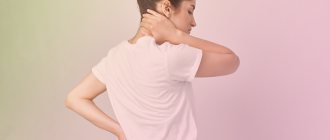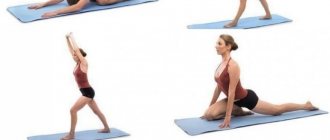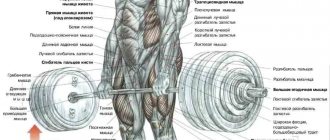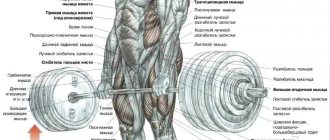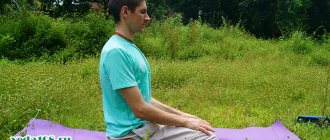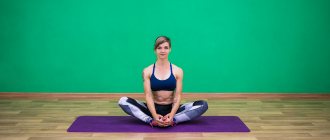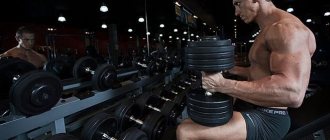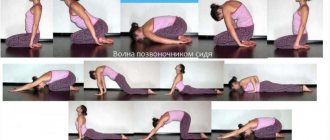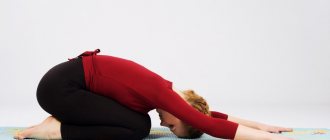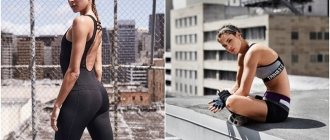As long as your spine is flexible, you are young and healthy! Remember this every time you are lazy to do yoga. The second thing that should immediately come to mind is cobra pose! It works great on your back... and more. We study the benefits of asana, contraindications and technique.
Bhujangasana is also known as cobra pose in yoga. An excellent product for the flexibility and health of your spine. Not everyone will master it right away at first, that’s true. But daily practice can work wonders!
This is especially useful for older people to know. Some suffer from radiculitis and apply “fiery” ointments to their lumbosacral region. Others are hunched over and cannot straighten their backs (yes, even young people are guilty of this!). They think that it will always be like this now. But water doesn’t flow under a lying stone! Start doing cobra pose for at least 1 minute a day. And to achieve a therapeutic effect: always under the supervision of an experienced instructor or doctor.
Bhujangasana - cobra snake pose
Snake pose is considered one of the main asanas in classical yoga practice. The technique of performing bhujangasana involves lying on your stomach with your body raised up. Support can be on your hands. The face looks at the ceiling or straight ahead. Legs extended along the floor. It is important to connect the movements of the arms and body with breathing cycles. This will make the snake pose even more effective.
The healing power of cobra asana lies in the fact that it is useful for normalizing the secretions of the internal glands, as well as improving the functioning of the kidneys and digestive system. With its help you can eliminate discomfort in the lumbar and thoracic spine. But bhujangasana has its contraindications. This is especially true for those who suffer from thyroid pathologies. They should be extremely careful while performing this exercise.
This asana energizes and gives strength, flexibility and elasticity to muscle tissue. If a person has slipped spinal discs, they can be eliminated with the help of bhujangasana. It also helps with osteochondrosis of the spine. But with hernias, you should be careful and before performing the cobra pose, you should consult an osteopath.
With the help of this asana, digestion improves, since the asana itself is supine, with the person lying on his stomach. Due to this position, internal massage of the organs is achieved, which has a beneficial effect on their functioning. In addition, bhajangasana is also effective for the functioning of the chakras. It helps manipura, svadhisthana, anahata and vishuddha to open up and become more harmonious.
End position
Bhujangasana pose has two options for the final position:
- Having arched your back, you can linger in the final pose exactly as long as the feeling of comfort allows you to do.
- For those who are more active, you can use a dynamic option: having reached the final position, you need to hold your breath for a few seconds, then lower it to the floor and repeat the asana several times.
While in the final position, you should pay attention to your shoulders - they should not be raised. The asana will be performed correctly only if the shoulders are lowered and turned back, and the chest is raised and straightened.
Description of the cobra pose
The name itself in translation means the word snake. This is where the description of the asana as a cobra or snake pose comes from. Bhujangasana itself resembles the movements of a snake when it opens its hood in the desire to rush at its prey, or when it becomes alert at the sight of something.
Snake pose is very beneficial for digestion. It is believed to ignite the inner fire and also allow kundalini energy to circulate better. It is also effective for opening and harmonizing a person’s chakras.
Execution step by step
Bhujangasana itself is very easy to perform. The stages of its implementation in the classic version are as follows:
- lie on the floor on your stomach;
- stretch your legs along the floor;
- place your hands under your shoulders and lean on them;
- lift the body up;
- gradually reach as high as possible towards the ceiling;
- throw your head back, reaching the top of your head towards your shoulders;
- make sure that the pubis does not come off the floor;
- strive to stretch your back as much as possible;
- delay in position for about 30 seconds;
- gradual return to a supine position.
The cobra exercise should be performed slowly and without sudden movements. If a person has problems with the spine, he should be very careful not to harm the already damaged spinal discs.
You can repeat the exercise up to 3 times. No more. Its effectiveness depends not on the number of repetitions, but on careful adherence to the exercise technique. Variants of performing ardha bhujangasana can be different.
Notes on practice
Breathing: inhale as you lift your body; in the final position, breathe normally, or hold your breath in case of dynamic performance; exhale as you lower your torso to the floor.
Duration of practice: you can perform up to 5 cycles per practice, gradually increasing the time you hold the final position (we are not talking about dynamic performance here, i.e. here you can breathe in the final position).
Attention: focus on combining breathing and movement, or on the Svadhisthana chakra.
Variations and modifications
In terms of psychological variations, bhujangasana can be performed with or without visualization, and with or without breathing techniques. In this case, if you visualize the thyroid gland or internal organs during the asana, you can improve their functioning.
The most common variations are sphinx pose or ardha bhujangasana, as well as purna bhujangasana, otherwise positioned as a more advanced version of the classic cobra asana.
Bhujangasana in an in-depth version has a better effect on the spine. It works as follows. All the first points of the exercise technique are performed in the same way as in the regular version, but when tilting your head back, you should pull your shoulders and head towards the tailbone as much as possible. The deflection in the spine should be maximum. This option is available only to those people who know how to perform the classic modification without unnecessary stress.
After the asana has ended, you can perform child’s pose and lie down for a while, completely relaxed.
The Sphinx pose is performed in this way: you need to lie on the floor with your stomach, put your forehead on the floor, while turning your feet with the soles up. The forearms should rest completely on the floor, similar to how the sphinx is positioned. The body must be completely relaxed. You can add meditation options or simply breathe using appropriate breathing techniques.
Vinyasa for Bhajangasana
If you want to incorporate an asana into your vinyasa practice, the most convenient precursor is Chaturanga Dandasana, which is part of the sun salutation. Perform Chaturanga Dandasana while exhaling and without stopping, gently lie down on your stomach. With the next exhalation, move to Bhujangasana. Otherwise, wait one breath cycle (calm inhalation, exhalation). Enter the asana as you inhale, and exhale as you exit (repeat this cycle six times).
After the last cobra exercise is completed, with an inhalation, enter the dog position with your head raised up, or prepare for Chaturanga Dandasana (putting your arms and legs) and enter the position with an exhalation.
Advantages and contraindications
Among the significant benefits are the positive effects on the spine and abdominal and back muscles. In addition, snake pose is very useful in yoga for stretching the entire body. It allows you to increase the flexibility of your back and the elasticity of your muscle tissue in a short period of time.
The benefits of the exercise are as follows:
- blood circulation in the spine improves;
- the nutrition of the intervertebral discs and the space between them improves;
- clamps and spasms are relieved;
- lung volume increases;
- pain in the thoracic back and lower back is eliminated;
- deep-lying muscle fibers of the back and abs are restored;
- the muscle frame is strengthened;
- the activity of the thyroid gland is stimulated;
- the impact of stress is reduced and fatigue is reduced.
Also, those people who perform bhujangasana quite often or regularly note that their insomnia has disappeared and they began to behave more calmly. It is important to take precautions and not practice bhujangasana if a person has any contraindications.
Benefit
- strengthens the spine;
- strengthens the buttocks;
- stretches the chest, shoulders and abdomen;
- expands the diaphragm and the heart area;
- stimulates the abdominal organs;
- relieves inflammation of the sciatic nerve;
- cures asthma;
- helps relieve stress and fatigue;
- Vedic texts say that Bhujangasana increases heat in the body, destroys diseases and awakens kundalini.
Precautions and contraindications
Bhujangasana is quite simple to perform, but like any other asana, it has its contraindications. Among them are:
- pregnancy period;
- serious pathologies of the spinal column;
- oncological diseases;
- severe respiratory diseases;
- pathologies of the cardiovascular system;
- hyperfunction of the thyroid gland.
As a precaution, it should be said that if there are any disorders of the thyroid gland, you should not throw your head too high or back. The cobra exercise or snake pose actually involves throwing your head back. Therefore, people with thyroid pathology should consult their doctor to avoid possible complications.
Who should not do the exercises?
Like any other type of physical activity, yoga has a number of contraindications, which you should definitely familiarize yourself with before starting training. It is also advisable to visit a doctor first to avoid a ban on classes.
So, the list of contraindications includes:
- exacerbation of spinal disease;
- serious injuries;
- infections, inflammations;
- recovery period after surgery;
- malignant tumor;
- high or low blood pressure, similarly with body temperature; migraine
- period of menstruation.
- mental illness;
- inguinal or vertebral hernia;
- traumatic brain injuries;
- scalene displacement of the vertebrae;
- arthrosis;
- suppuration;
- ARVI and acute respiratory infections;
Age is not prohibited when starting classes. Yoga is beneficial for both young and old people.
Advice for beginners
In hatha yoga, bhujangasana is quite popular and is considered one of the accessible asanas. In practice, it can be convincingly said that the simplified version can be performed by almost anyone. It does not have a negative effect on the human body if the person follows precautions and does not practice bhujangasana if there are any contraindications.
Important points when performing the asana are the following:
- your palms should be pressed as hard as possible onto the floor;
- pull your shoulders back;
- open your chest;
- throw your head back, trying to reach the top of your head towards your tailbone;
- It is better to place your legs next to each other and try to stretch them further along the floor;
- It is best to squeeze your gluteal muscles.
It is best to lift the body upward by tensing the back muscles. This way they will pump more strongly, and the tension will go away faster. If you experience any discomfort or pain in your back, it is better to stop doing the exercise.
Bhujangasana helps the kundalini energy to move freely along the spine. In order to improve the sphere of influence of bhujangasana on the activity of the chakras, it is necessary to visualize or meditate during practice.
For people with a bad spine, you can start by choosing a sphinx asana for yourself. It is considered a lighter version of the exercise. If a person does not have any pathologies, then you can proceed to either a classical or a complicated modification of bhujangasana.
The most common mistakes that people make at the initial stages of practice:
- the pubic bone is not pressed firmly to the floor;
- the chest is not open enough;
- The head is not thrown back well enough.
In order for the bhujangasana exercise to be effective, the technique should be performed with extreme caution, without missing the slightest moment. Every little detail in the asana has its own meaning.
Common execution errors
The most frequently repeated shortcomings when performing the Snake pose:
- Incorrect hand placement. The palms should be located next to the body. If they are too wide, then the shoulder blades are compressed, resulting in a different asana.
- Tension in the elbow joint. Your arms should be slightly bent at the elbows.
- The head is thrown back too far. It should be raised so that the eyes look forward.
- Kink in the lumbar region. Only experienced yogis can lift the body vertically. A strong arch is very dangerous for health, so you should not rush to bend your back so much.
- Tension in the buttocks. The gluteal muscles should be as relaxed as possible.
- Legs casually spread. There are several options for the Snake pose: with the hind limbs spread and closed. Proper positioning of the legs allows you to evenly distribute body weight.
Complicating the asana
People who have been practicing yoga for a long time often get bored with the classic cobra pose, so they look for options for modifying it. You can complicate the asana like this:
- First, the usual Bhujangasana is done, the feet are crossed, and after a while the crosshairs change and the pose is repeated again. If a person suffers from scoliosis, the sensations when crossing the legs will be different, so you should find a position in which the asana is more difficult to perform, and stay in it a little longer.
- After performing the classic cobra pose, you need to inhale and turn your body to the right, directing your gaze to your left heel and holding your breath. As you exhale, you should return to the starting position, and then inhale and repeat the same in the other direction.
- Having completed the final version of the asana, you need to move your chest a little forward, while simultaneously lifting it even higher, while increasing the deflection and moving your head as far back as possible. When performing this version of the cobra pose, it is necessary to evenly distribute tension throughout the body (starting from the feet joined together and up to the top of the head).
